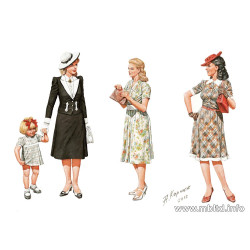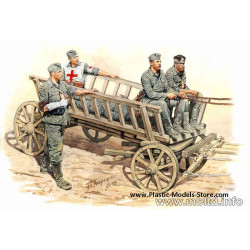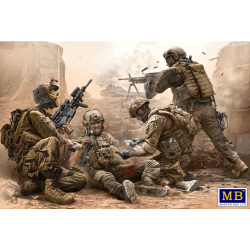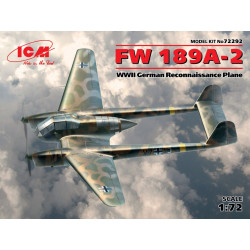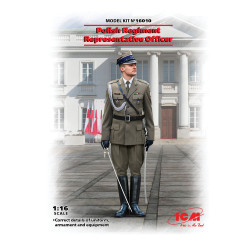

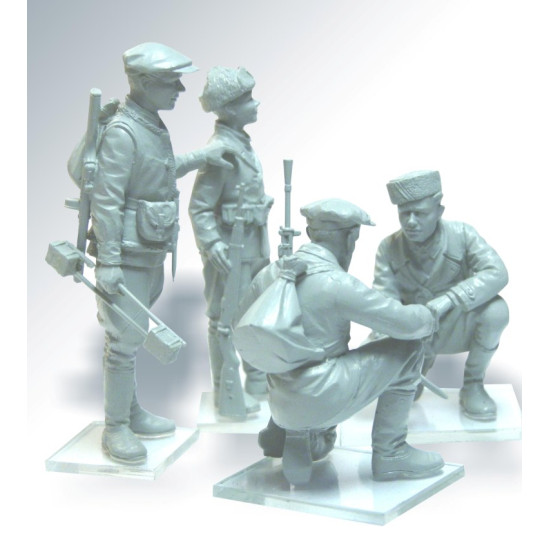





















WWII Soviet Partisans
1/35 military figures scale plastic model kit
ICM 35631
High-quality details.
Manufacturer: ICM Models (Ukraine)
Scale: 1/35
Material: Plastic
Number of figures: 3
Paint: Unpainted, Unassembled, Kit do not contain paints and glue.
Condition: New in Box
The Soviet partisans were members of a resistance movement which fought a guerrilla war against the Axis occupation of the Soviet Union during World War II.
The movement was coordinated and controlled by the Soviet government and modeled on that of the Red Army. The primary objective of the guerrilla warfare waged by the Soviet partisan units was the disruption of the Eastern Front's German rear, especially road and railroad communications. There were also regular military formations, also called partisans, that were used to conduct long-range reconnaissance patrol missions behind enemy lines from bases within Soviet-held territory.The program of the partisan war was outlined in the Soviet People's Commissaries Council and Communist Party directives issued on July 29, 1941 and in following documents. Partisan detachments and diversionist groups were to be formed in the German-occupied territories, road and telecommunications disrupted, German personnel killed, and valuable resources destroyed. Joseph Stalin, in his radio speech on August 3, 1941, iterated these commands and directives to the people. Adolf Hitler, when referring to that speech on August 16, pointed out that the declared partisan war in the German rear had its advantages, providing the excuse for destroying "anything that opposes [the Germans]".
The first partisan detachments, consisting of Red Army personnel and local people, and commanded by Red Army officers or local Communist Party activists, were formed in the first days of the war, including the Starasyel'ski detachment of Major Dorodnykh in theZhabinka district (June 23, 1941), the Pinsk detachment of Vasily Korzh on June 26, 1941.[3] The first awards of the Hero of the Soviet Union order occurred on August 6, 1941 (detachment commanders Pavlovskiy and Bumazhkov).
In 1941, the core of the social base of the partisan movement were the remains of Red Army units destroyed in the first phases of Operation Barbarossa, personnel of destruction battalions, and the local Communist Party and Komsomol activists. The most common unit of the period was the detachment.
1943-1944
Belarussian partisans in the forest nearPolotsk, Belarussian SSR September 1943.
Soviet partisans on the road in Belarus, 1944.
The buildup of the Soviet partisan force in western Belarus was ordered and implemented during 1943, with nine brigades, 10 detachments and 15 operational groups transferred from east to west, effectively tripling the partisan force there (reaching 36,000 troops in December 1943). It is estimated that 10-12,000 personnel were transferred, and about same number came from local volunteers. The buildup of the military force was complemented by the intensification of the underground Communist Party structures and propaganda activity.[20]
The Soviet victory at Stalingrad, a certain lessening of the terror campaign (de factofrom December 1942, formally permitted in February 1943) and an amnesty promised to collaborators who wished to return to the Soviet camp were significant factors in the 1943 growth of Soviet partisan forces. Desertions from the ranks of the German-controlled police and military formations strengthened units, with sometimes whole detachments coming over to the Soviet camp, including the Volga Tatar battalion (900 personnel, February 1943), and Gil-Rodionov's 1st Russian People's Brigade of the SS (2,500 personnel, August 1943). In all about 7,000 people of different anti-Soviet formations joined the Soviet partisan force, while about 1,900 specialists and commanders were dropped into occupied Belarus in 1943. However, local people mainly accounted for most increases in the Soviet partisan force.
In autumn 1943, the partisan force in the Belarusian SSR numbered about 153,000,and by the end of 1943 numbers reached about 122,000, with about 30,000 put behind the front line in the course of the liberation of the eastern parts of the Belarusian SSR (end 1943). The partisan movement was so strong that by 1943-1944 there were entire regions in occupied Belarus where Soviet authority was re-established deep inside the German held territories. There were even partisan kolkhozes raising crops and livestock to produce food for the partisans.
During the battles for the liberation of Belarus, partisans comprised the fourth Belorussian front. After the liberation of the Belarusian SSR, about 180,000 partisans joined the Soviet Army in 1944.
During the 1941-1944 period, the total numbers of the Soviet partisan force in Belarus reached 374,000, about 70,000 in the urban underground, and about 400,000 in the reserves. Among Soviet partisans in Belarus were people of 45 different nationalities and 4,000 non-Soviet citizens (including 3,000 Poles, 400 Czechs and Slovaks, 300 Yugoslavians, etc.). Around 65% of Belarusian partisans were local people.
| General Product Info | |
| Material | Plastic |
| Scale | 1/35 |
| Type | NOT SET |
We have the lowest worldwide shipping. And it's totally simple.
EUROPE, USA, CANADA TURKEY, ISRAEL, EGYPT, UE CHINA, JAPAN, HK, S.KOREA | AU NZ MX South America, Asia | |
| Order weight up to 0.22kg or 0.48lb | US$ 8.90 | US$ 8.90 |
| Order weight up to 0.44kg or 0.97lb | US$ 13.95 | US$ 17.90 |
| Order weight over 0.44kg or 0.97lb | US$ 19.99 | US$ 29.99 |
| Order total over $150 | FREE | PROMO US$ 19.99 |
Shipping to some countries not qualifies for the free shipping option but costs not over $29.99 for any sized order. Sorry for that, your location is too far.
- Stock: Out Of Stock
- Model: ICM35631
- Weight: 0.32lb
- DATE ADDED: 27/02/2014




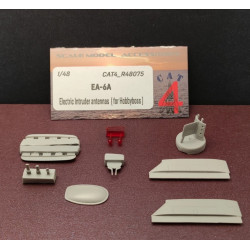

















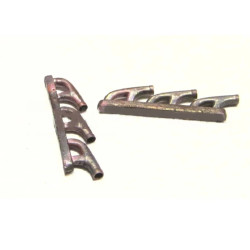









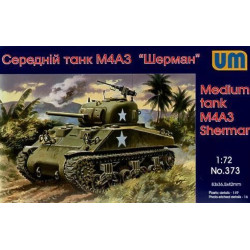









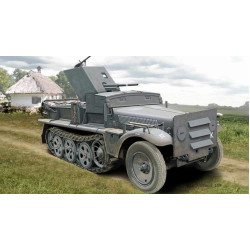
































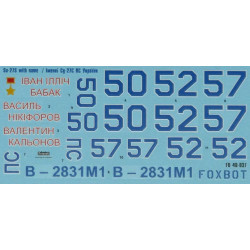













































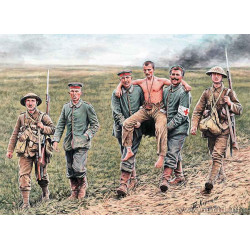







-250x250w.JPG)
-250x250w.JPG)


